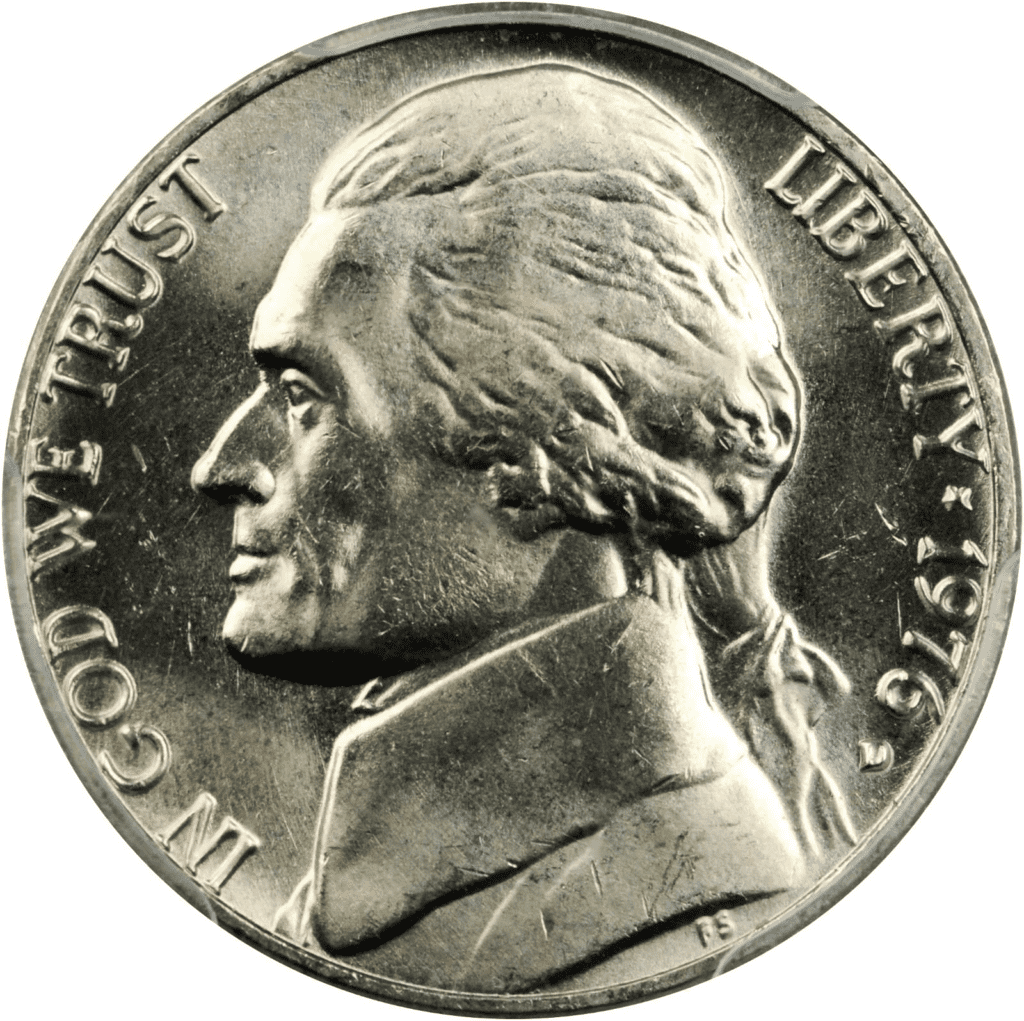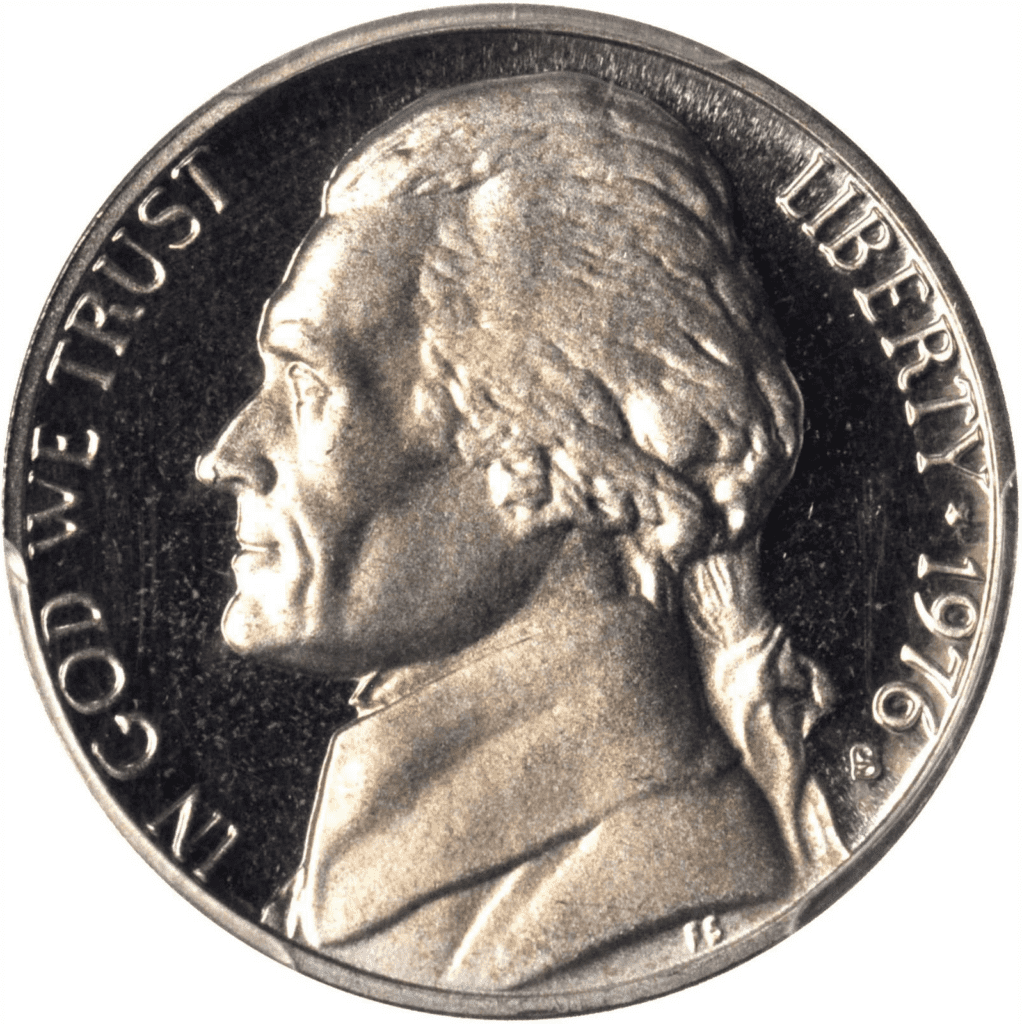What Is A 1976 Jefferson Nickel Made Of?
The 1976 Jefferson nickel is made of 75% copper and 25% nickel. It has a diameter of 21.2 mm and a mass of 5 g. Its face value is $0.05 and was issued in 1976.
The 1976 Jefferson nickel doesn’t have silver in it. The silver nickel was instead produced from 1792 to 1873 and not in 1976.
The 1976 Jefferson nickel’s obverse features the bust of Thomas Jefferson facing left. The inscriptions include the following:
- IN GOD WE TRUST
- LIBERTY
- 1976
- FS (Designer’s initial)
On the reverse side, the prominent image is the Monticello mansion, the home of Jefferson. Various inscriptions can be seen, which include the following:
- PLURIBUS UNUM
- MONTICELLO
- FIVE CENTS
- UNITED STATES OF AMERICA
The nickel was designed by Felix Schlag, an American sculptor. The Jefferson nickel was issued in 1938. In 2004 and 2005, a new Jefferson nickel was made to honor the Lewis and Clark Expedition bicentennial anniversary. In 2006, the nickel’s original Jefferson design was used again.
1976 Jefferson Nickel Varieties
The 1976 Jefferson nickel comes in different varieties. Most of them differ in their mint mark. However, some nickels differ because of one or more errors that it received.
To get familiar with these varieties, take a look at them below:
1976 P Nickel (No Mint Mark)
Edge: Smooth
Mint Mark: No mint mark
Place of minting: Philadelphia
Year: 1976
Face Value: $0.05 (five cents)
Price: $0.05 to $1.25 (or more)
Quantity produced: 367,124,000
Composition: 75% copper and 25% nickel
Mass: 5 grams
Diameter: 21.21 mm
Thickness: 1.95 mm

photo source: USA Coin Book
The 1976 P Nickel (No Mint Mark) was minted in Philadelphia. There are more than 360 million of these nickels made. You can sell this nickel for as much as $1.25 depending on its condition.
1976 D Nickel
Edge: Smooth
Mint Mark: D
Place of minting: Denver
Year: 1976
Face Value: $0.05 (five cents)
Price: $0.05 to $18.00 (or more)
Quantity produced: 563,964,000
Composition: 75% copper and 25% nickel
Mass: 5 grams
Diameter: 21.21 mm
Thickness: 1.95 mm

photo source: Coin Appraiser
The 1976 D Nickel was minted in Denver. There are more than 560 million of these nickels made. You can sell this nickel for as much as $18.00 depending on its condition.
1976 S Nickel
Edge: Smooth
Mint Mark: S
Place of minting: San Francisco
Year: 1976
Face Value: $0.05 (five cents)
Price: $0.05 to $3.50 (or more)
Quantity produced: 4,149,000
Composition: 75% copper and 25% nickel
Mass: 5 grams
Diameter: 21.21 mm
Thickness: 1.95 mm

photo source: Coin Appraiser
The 1976 S Nickel was minted in San Francisco. There are more than 4 million of these nickels made. You can sell this nickel for as much as $3.50 depending on its condition.
The 1976 S Nickel was minted in San Francisco. There are more than 4 million of these nickels made. You can sell this nickel for as much as $3.50 depending on its condition.
List of errors
With more than 900 million 1976 nickels produced, it is not surprising to note that some of these nickels were made with one or more errors.
Like other coins, some of the common errors would include off-center strike, broad strike, doubled die strike, folded planchet, blank planchet, and broken die, just to name a few.
How Much Is A 1976 Jefferson Nickel Worth Today?
Standard, common, and ordinary 1976 Jefferson nickels are only worth their face value, which is $0.05. Its melt value is about $0.56 However, if you have uncirculated, unique, and attractive nickels, you may be able to sell them for a higher price.
Here’s a table to give you an idea of how much 1976 nickel coins are:
| Coin | Condition | Grade | Price |
| Ordinary 1976 Jefferson nickel | Circulated | Not graded | $0.05 |
| 1976 S Jefferson nickel | Uncirculated | MS 63 | $4.00 |
| 1976 D Jefferson nickel | Uncirculated | MS 63 | $18.00 |
Please note that prices can dramatically increase if your nickel has a rare quality, impressive eye appeal, and special features.
How Does The Grading System Work?
The Sheldon Scale is used by numismatists to provide a numerical value to coins. The Sheldon Scale goes from poor (P-1) to perfect mint state (P-1) (MS-70). Coins were originally evaluated using words to reflect their condition (Good, Fair, Excellent, Etc.). Unfortunately, coin collectors and dealers had different ideas about what each of these terms represent.
Professional numismatists joined together in the 1970s and established CoinGrading standards. These numismatists now assign grades at key places on the seventy-point scale, using the most regularly utilized numeric points in conjunction with the original adjective grade. The following are the most common coin grades:
-
-
- (P-1) Poor – Indistinguishable and probably damaged; if used, must have a date and mintmark; otherwise, rather battered.
- (FR-2) Fair – Nearly smooth, but without the damage that a coin graded Poor often possesses. The coin must have enough detail to be identified.
- (G-4) Fair – Inscriptions have merged into the rims in some areas, and important elements have been mostly erased.
- (VG-8) Very Good- A little weathered, but all of the primary design elements are visible, albeit faintly. There is little if any, central detail left.
- (F-12) Good – The item is very worn, yet the wear is even, and the overall design details stand out clearly. Rims are almost completely isolated from the field.
- (VF-20) Very Fine – Moderately weathered, with some finer features still visible. The motto or all letters of LIBERTY are readable. Both sides of the coin have entire rims that are separated from the field.
- (EF-40) Extremely Fine – Gently used; all gadgets are visible, and the most important ones are bold. The finer details are bold and clear, however, light wear may be seen.
- (AU-50) Uncirculated – Slight evidence of wear on the coin’s design’s high points; may have contact marks; eye appeal should be adequate.
- (AU-58) Uncirculated Choice – Slight traces of wear, no severe contact marks, almost full mint shine, and great eye appeal.
- (MS-60) Mint State Basal – Strictly uncirculated; no indication of wear on the coin’s highest points, but an unsightly coin with reduced luster, visible contact marks, hairlines, and other flaws.
- (MS-63) Mint State Acceptable – Uncirculated, but with contact scratches and nicks, little reduced shine, but otherwise appealing appearance. The strike is weak to average.
- (MS-65) Mint State Choice – Uncirculated with great mint shine, very little contact blemishes, and exceptional eye appeal. The strike is unusually severe.
- (MS-68) Mint State Premium Quality – Uncirculated with superb luster, no obvious contact marks to the naked eye, and exceptional eye appeal. The strike is quick and appealing.
- (MS-69) Almost Perfect Mint State – Uncirculated with perfect brilliance, a sharp and appealing strike, and extremely good eye appeal. A near-perfect coin with minor imperfections in the planchet, strike, and contact markings (seen only under 8x magnification).
- (MS-70) Mint State Perfect – Under 8x magnification, there are no tiny imperfections discernible; the strike is crisp, and the coin is perfectly centered on a beautiful planchet. Rarely seen on a coin, this coin is bright and whole, with original luster and exceptional eye appeal.
-
Where To Buy Or Sell 1976 Jefferson Nickels?
You can buy or sell 1976 Jefferson nickels online. If you want to instantly find Jefferson nickels, you can simply go to the Internet. With just a few clicks of a button, you should be able to buy new nickels or sell your coins. For specific websites, you can try Amazon, eBay, and USA Coin Book.
Aside from the Internet, you can go to your local coin shops, coin exchanges, antique stores, and collector’s places. Try joining coin clubs. Members can also help you know where you can buy or sell 1976 Jefferson nickels.
FAQs
Where is the mint mark on a 1976 Jefferson nickel?
You can find the 1976 Jefferson nickel mint mark on the obverse, below the 1976 date. In the past, particularly nickels made from 1938 to 1964, the mint mark can be found on the reverse side of the coin. There were no added mint marks for nickels made from 1965 to 1967.
What nickels have the most silver?
The war nickels are considered to have the most silver content among all varieties of nickels. They are called war nickels because they were produced from mid-1942 to 1945. Nickels produced at this time are 35% silver, 9% manganese, and 56% copper.
What is the rarest nickel?
The nickel that is considered to be the rarest is the 1913 Liberty Head V. Since it’s the rarest, it is also the most valuable nickel. Today, the price of this rare nickel is $4,228,955. Other rare nickels include 1880 Shield Nickel ($20,000), 1924 S Buffalo Nickel ($14,000), 1926 S Buffalo Nickel ($7,600), and 1927 S Buffalo Nickel ($5,000).
What years are the most valuable Jefferson nickels?
The most valuable Jefferson nickels are the ones with the year 1913, 1880, 1885, 1919, 1920, 1926, 1927, 1936, 1937, 1942, and 1964.



